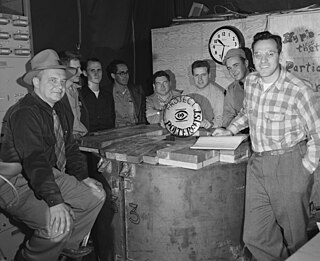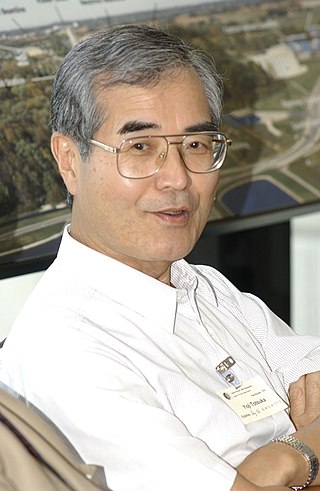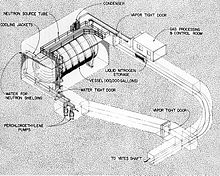
A neutrino is a fermion that interacts only via the weak interaction and gravity. The neutrino is so named because it is electrically neutral and because its rest mass is so small (-ino) that it was long thought to be zero. The rest mass of the neutrino is much smaller than that of the other known elementary particles. The weak force has a very short range, the gravitational interaction is extremely weak due to the very small mass of the neutrino, and neutrinos do not participate in the electromagnetic interaction or the strong interaction. Thus, neutrinos typically pass through normal matter unimpeded and undetected.

The Sudbury Neutrino Observatory (SNO) was a neutrino observatory located 2100 m underground in Vale's Creighton Mine in Sudbury, Ontario, Canada. The detector was designed to detect solar neutrinos through their interactions with a large tank of heavy water.

Super-Kamiokande is a neutrino observatory located under Mount Ikeno near the city of Hida, Gifu Prefecture, Japan. It is located 1,000 m (3,300 ft) underground in the Mozumi Mine in Hida's Kamioka area. The observatory was designed to detect high-energy neutrinos, to search for proton decay, study solar and atmospheric neutrinos, and keep watch for supernovae in the Milky Way Galaxy.

Masatoshi Koshiba was a Japanese physicist and one of the founders of neutrino astronomy. His work with the neutrino detectors Kamiokande and Super-Kamiokande was instrumental in detecting solar neutrinos, providing experimental evidence for the solar neutrino problem.

The Cowan–Reines neutrino experiment was conducted by physicists Clyde Cowan and Frederick Reines in 1956. The experiment confirmed the existence of neutrinos. Neutrinos, subatomic particles with no electric charge and very small mass, had been conjectured to be an essential particle in beta decay processes in the 1930s. With neither mass nor charge, such particles appeared to be impossible to detect. The experiment exploited a huge flux of electron antineutrinos emanating from a nearby nuclear reactor and a detector consisting of large tanks of water. Neutrino interactions with the protons of the water were observed, verifying the existence and basic properties of this particle for the first time.

Raymond Davis Jr. was an American chemist and physicist. He is best known as the leader of the Homestake experiment in the 1960s-1980s, which was the first experiment to detect neutrinos emitted from the Sun; for this he shared the 2002 Nobel Prize in Physics.

A solar neutrino is a neutrino originating from nuclear fusion in the Sun's core, and is the most common type of neutrino passing through any source observed on Earth at any particular moment. Neutrinos are elementary particles with extremely small rest mass and a neutral electric charge. They only interact with matter via the weak interaction and gravity, making their detection very difficult. This has led to the now-resolved solar neutrino problem. Much is now known about solar neutrinos, but the research in this field is ongoing.

A neutrino detector is a physics apparatus which is designed to study neutrinos. Because neutrinos only weakly interact with other particles of matter, neutrino detectors must be very large to detect a significant number of neutrinos. Neutrino detectors are often built underground, to isolate the detector from cosmic rays and other background radiation. The field of neutrino astronomy is still very much in its infancy – the only confirmed extraterrestrial sources as of 2018 are the Sun and the supernova 1987A in the nearby Large Magellanic Cloud. Another likely source is the blazar TXS 0506+056 about 3.7 billion light years away. Neutrino observatories will "give astronomers fresh eyes with which to study the universe".
T2K is a particle physics experiment studying the oscillations of the accelerator neutrinos. The experiment is conducted in Japan by the international cooperation of about 500 physicists and engineers with over 60 research institutions from several countries from Europe, Asia and North America and it is a recognized CERN experiment (RE13). T2K collected data within its first phase of operation from 2010 till 2021. The second phase of data taking (T2K-II) is expected to start in 2023 and last until commencement of the successor of T2K – the Hyper-Kamiokande experiment in 2027.
The standard solar model (SSM) is a mathematical treatment of the Sun as a spherical ball of gas. This model, technically the spherically symmetric quasi-static model of a star, has stellar structure described by several differential equations derived from basic physical principles. The model is constrained by boundary conditions, namely the luminosity, radius, age and composition of the Sun, which are well determined. The age of the Sun cannot be measured directly; one way to estimate it is from the age of the oldest meteorites, and models of the evolution of the Solar System. The composition in the photosphere of the modern-day Sun, by mass, is 74.9% hydrogen and 23.8% helium. All heavier elements, called metals in astronomy, account for less than 2 percent of the mass. The SSM is used to test the validity of stellar evolution theory. In fact, the only way to determine the two free parameters of the stellar evolution model, the helium abundance and the mixing length parameter, are to adjust the SSM to "fit" the observed Sun.

Hyper-Kamiokande is a neutrino observatory and experiment under construction, conducted in Japan by the collaboration of institutes from 21 countries from six continents. As a successor of the Super-Kamiokande (SK) and T2K experiments, it is designed to search for proton decay and detect neutrinos from natural sources such as the Earth, the atmosphere, the Sun and the cosmos, as well as to study neutrino oscillations of the man-made accelerator neutrino beam. The beginning of data-taking is planned for 2027.
The Kamioka Observatory, Institute for Cosmic Ray Research is a neutrino and gravitational waves laboratory located underground in the Mozumi mine of the Kamioka Mining and Smelting Co. near the Kamioka section of the city of Hida in Gifu Prefecture, Japan. A set of groundbreaking neutrino experiments have taken place at the observatory over the past two decades. All of the experiments have been very large and have contributed substantially to the advancement of particle physics, in particular to the study of neutrino astronomy and neutrino oscillation.

SNO+ is a physics experiment designed to search for neutrinoless double beta decay, with secondary measurements of proton–electron–proton (pep) solar neutrinos, geoneutrinos from radioactive decays in the Earth, and reactor neutrinos. It is under construction using the underground equipment already installed for the former Sudbury Neutrino Observatory (SNO) experiment at SNOLAB. It could also observe supernovae neutrinos if a supernova occurs in our galaxy.
GALLEX or Gallium Experiment was a radiochemical neutrino detection experiment that ran between 1991 and 1997 at the Laboratori Nazionali del Gran Sasso (LNGS). This project was performed by an international collaboration of French, German, Italian, Israeli, Polish and American scientists led by the Max-Planck-Institut für Kernphysik Heidelberg. After brief interruption, the experiment was continued under a new name GNO from May 1998 to April 2003.
The Sanford Underground Research Facility (SURF), or Sanford Lab, is an underground laboratory in Lead, South Dakota. The deepest underground laboratory in the United States, it houses multiple experiments in areas such as dark matter and neutrino physics research, biology, geology and engineering. There are currently 28 active research projects housed within the facility.

Yoji Totsuka was a Japanese physicist and Special University Professor, Emeritus, University of Tokyo. A leader in the study of solar and atmospheric neutrinos, he was a scientist and director at Kamioka Observatory, Super-Kamiokande and the High Energy Physics Laboratory (KEK) in Japan.
The solar neutrino problem concerned a large discrepancy between the flux of solar neutrinos as predicted from the Sun's luminosity and as measured directly. The discrepancy was first observed in the mid-1960s and was resolved around 2002.
Herbert Hwa-sen Chen was a theoretical and experimental physicist at the University of California at Irvine known for his contributions in the field of neutrino detection. Chen's work on observations of elastic neutrino-electron scattering provided important experimental support for the electroweak theory of the standard model of particle physics. In 1984 Chen realized that the deuterium of heavy water could be used as a detector that would distinguish the flavors of solar neutrinos. This idea led Chen to develop plans for the Sudbury Neutrino Observatory that would eventually make fundamental measurements demonstrating that neutrinos were particles with mass.
Eugene William Beier is an American physicist.
The diffuse supernova neutrino background(DSNB) is a theoretical population of neutrinos (and anti-neutrinos) cumulatively originating from all core-collapse supernovae events throughout the history of the universe. Though it has not yet been directly detected, the DSNB is theorized to be isotropic and consists of neutrinos with typical energies on the scale of 107 eV. Current detection efforts are limited by the influence of background noise in the search for DSNB neutrinos and are therefore limited to placing limits on the parameters of the DSNB, namely the neutrino flux. Restrictions on these parameters have gotten more strict in recent years, but many researchers are looking to make direct observations in the near future with next generation detectors. The DSNB is not to be confused with the cosmic neutrino background (CNB), which is comprised by relic neutrinos that were produced during the Big Bang and have much lower energies (10−4 to 10−6 eV).












